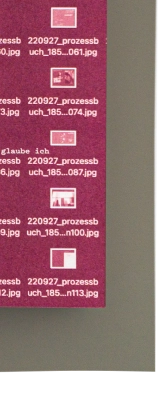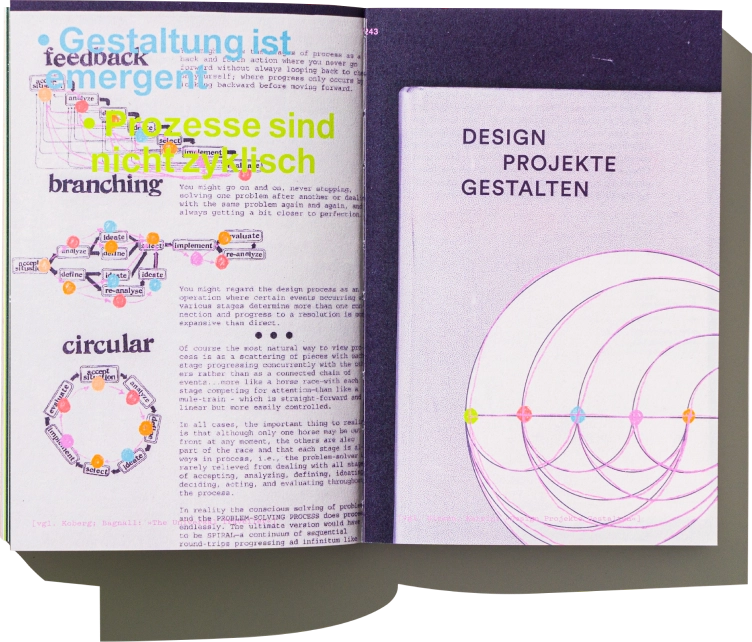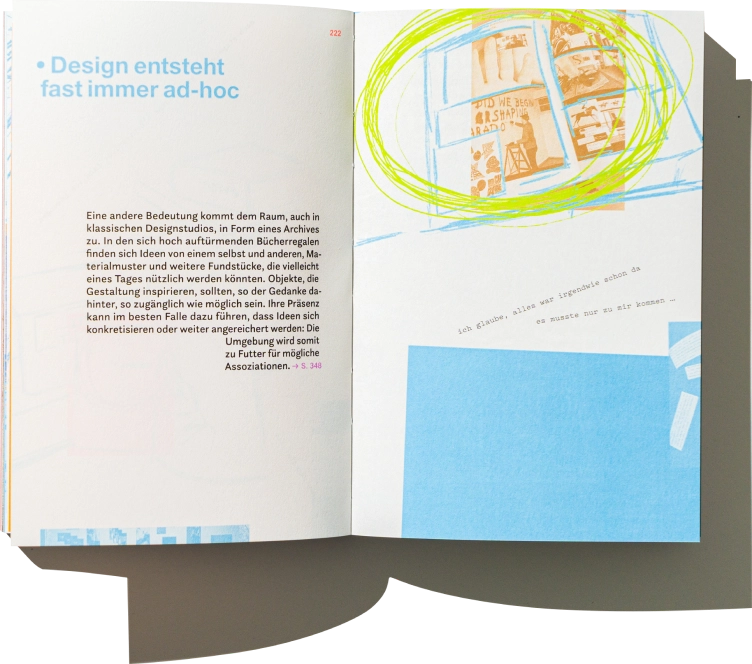»When working alone, I’m a yoyo.«

»Models make design tangible.«

»Carrying on is the best strategy«
»Design is emergent.«
»Designing takes courage.«
● This book is process



How do design processes unfold? When, where, with what, and through whose actions? And how can they be enhanced to foster a more open-ended design process?
“Gestaltung als Prozess” (Design as Process) is an exploration of the processes within design. It delves into their intricacies through various layers of images and text. The book comprises two comprehensive essays—one written, one visual—interlinked throughout the publication.
Filled with layers of thoughts, ideas, and references, it spans 464 pages as a quest for solutions to the problems of the process unfolds. An exhibition accompanied the book.
● It provides an answer to its genesis
The first of the two essays within the book, the visual one, is structured around 15 chapters focusing on aspects of the design process. These chapters are presented as zine-style booklets, each the size of one signature, revealed on the book’s spine. With topics like quantity, culture or coincidence, they examine aspects of the design process on an abstract, concrete or personal level.
The written essay serves as an inventory of academic and non-academic design research, as well as personal experiences. Process is examined across four dimensions: time, space, media, and actors. It raises questions about how different aspects of these dimensions impact the design process, how they intersect, and how the process itself must be considered as an intricate, interconnected, incredibly intriguing entity as a result.


● Everything within is connected

Throughout the whole book crude thoughts, bold statements, and elaborate argumentations create a reflection of different levels of process while the visual language draws from the tangled nature of the design process itself.
The design concept is informed by notions of thought, reference, and linkage: Text types and sources of the wirtten essay are conveyed through their respective visual languages. Links between the essays are created through excerpts and miniature images. Spreads designed based on printing sheets lead to non-linear narrations. Post-it-like colors emphazise understanding…


»Design gets inspired by environment«



»Quantity leads to quality.«

»Pauses are process too.«

● It spans 464 pages



● A process informed the contents
The content of the book was developed concurrently with the book’s design in a recursive process. There has been a consistent response to new input through sketches and notes. However, the most crucial aspect has been the ongoing dialogue with an interdisciplinary group of people, which greatly contributed to the articulation of ideas. The process has only just begun.

● There’s more to be said
● Contact me via info@fyrguth.de
»Design as Process«
by Sarah Fyrguth


● This book is process

How do design processes unfold? When, where, with what, and through whose actions? And how can they be enhanced to foster a more open-ended design process?
“Gestaltung als Prozess” (Design as Process) is an exploration of the processes within design. It delves into their intricacies through various layers of images and text. The book comprises two comprehensive essays—one written, one visual—interlinked throughout the publication.
Filled with layers of thoughts, ideas, and references, it spans 464 pages as a quest for solutions to the problems of the process unfolds. An exhibition accompanied the book.
● It provides an answer to its genesis

The first of the two essays within the book, the visual one, is structured around 15 chapters focusing on aspects of the design process. These chapters are presented as zine-style booklets, each the size of one signature, revealed on the book’s spine. With topics like quantity, culture or coincidence, they examine aspects of the design process on an abstract, concrete or personal level.
The written essay serves as an inventory of academic and non-academic design research, as well as personal experiences. Process is examined across four dimensions: time, space, media, and actors. It raises questions about how different aspects of these dimensions impact the design process, how they intersect, and how the process itself must be considered as an intricate, interconnected entity as a result.
● Everything within is connected

Throughout the whole book crude thoughts, bold statements, and elaborate argumentations create a reflection of different levels of process while the visual language draws from the tangled nature of the design process itself.
Therefore the design concept is informed by notions of thought, reference, and linkage: Text types and sources of the wirtten essay are conveyed through their respective visual languages. Links between the essays are created through excerpts and miniature images. Spreads designed based on printing sheets lead to non-linear narrations. Post-it-like colors emphazise understanding…

● Its two parts span 464 pages
● A process informed the contents

The content of the book was developed concurrently with the book’s design in a recursive process. There has been a consistent response to new input through sketches and notes. However, the most crucial aspect has been the ongoing dialogue with an interdisciplinary group of people, which greatly contributed to the articulation of ideas. The process has only just begun.







